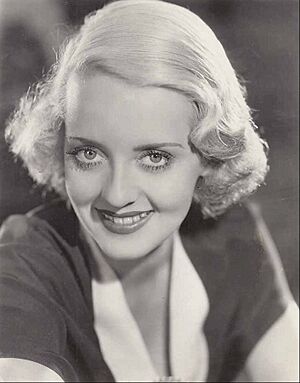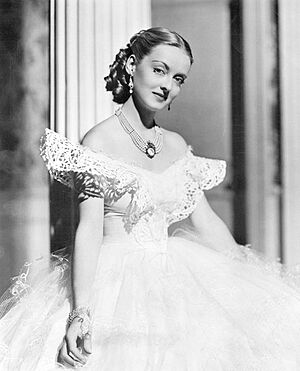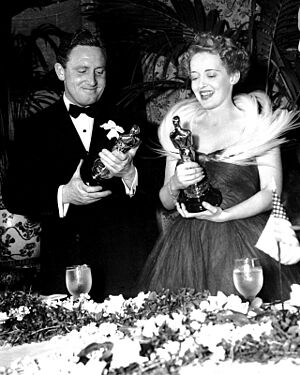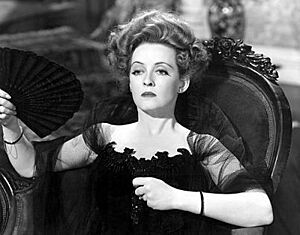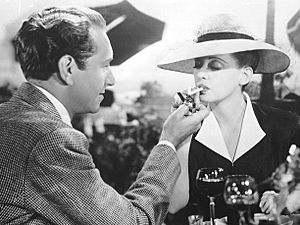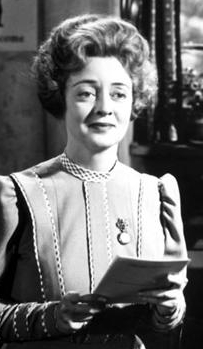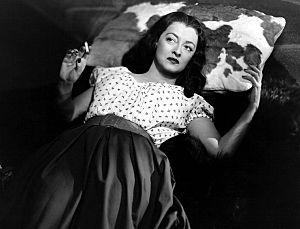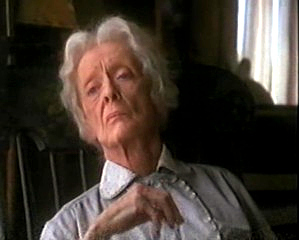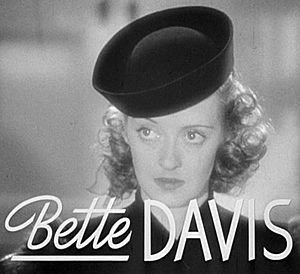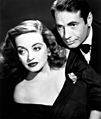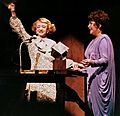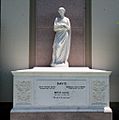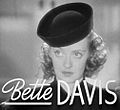Bette Davis facts for kids
Quick facts for kids
Bette Davis
|
|
|---|---|
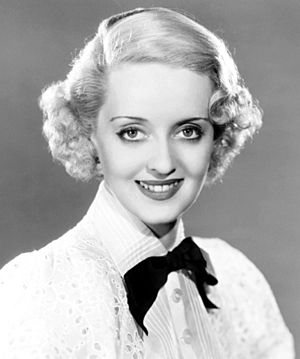
Davis in 1935
|
|
| Born |
Ruth Elizabeth Davis
April 5, 1908 Lowell, Massachusetts, U.S.
|
| Died | October 6, 1989 (aged 81) Neuilly-sur-Seine, France
|
| Resting place | Forest Lawn Memorial Park |
| Occupation | Actress |
| Years active | 1929–1989 |
| Political party | Democratic |
| Spouse(s) |
|
| Children | 3, including B. D. Hyman |
| Signature | |
Bette Davis (born Ruth Elizabeth Davis; April 5, 1908 – October 6, 1989) was a famous American actress. Her career lasted over 50 years, and she appeared in more than 100 films and TV shows. She was known for playing strong, sometimes tough characters. Bette Davis starred in many types of movies, including dramas, thrillers, and even comedies.
She won two Academy Awards (Oscars) for her acting. Bette Davis was also the first actor to receive ten Oscar nominations. She started on Broadway in New York before moving to Hollywood in 1930.
After a few small roles, she became famous for her part in Of Human Bondage (1934). The next year, she won her first Oscar for Dangerous (1935). In 1937, she tried to leave her contract with Warner Bros. Studio. Even though she lost the court case, it helped her become one of the most celebrated actresses in the U.S. for over ten years.
Bette Davis was known for her powerful acting style. She was a perfectionist and expected high standards from everyone she worked with. Her direct way of speaking and her famous cigarette became part of her public image.
She played a Broadway star in All About Eve (1950), which earned her another Oscar nomination. She also won the Cannes Film Festival Award for Best Actress for this role. Her last Oscar nomination was for What Ever Happened to Baby Jane? (1962). In this film, she starred alongside her famous rival, Joan Crawford.
Later in her career, she had successful roles in Death on the Nile (1978) and The Whales of August (1987). Despite health problems, she kept acting until shortly before she passed away in 1989. Bette Davis was married four times and raised her children mostly as a single parent. Her daughter, B. D. Hyman, wrote a book about her childhood.
Davis also helped start the Hollywood Canteen. This was a free club for soldiers during World War II, offering food, dancing, and entertainment. She was the first female president of the Academy of Motion Picture Arts and Sciences. She was also the first woman to receive a Lifetime Achievement Award from the American Film Institute. In 1999, the American Film Institute ranked Bette Davis as the second greatest female star in classic Hollywood cinema.
Contents
- Bette Davis: Her Life and Career
- Early Life and Acting Dreams (1908–1929)
- Hollywood Beginnings (1930–1936)
- Warner Bros. Success (1937–1941)
- War Efforts and Personal Life (1942–1944)
- Career Challenges (1945–1949)
- New Beginnings (1949–1960)
- Renewed Success (1961–1970)
- Later Career and Awards (1971–1983)
- Final Years and Legacy (1983–1989)
- Death
- Academy Awards
- Selected Filmography
- Images for kids
- See also
Bette Davis: Her Life and Career
Early Life and Acting Dreams (1908–1929)
Ruth Elizabeth Davis was born on April 5, 1908, in Lowell, Massachusetts. Everyone called her "Betty" when she was little. Her father, Harlow Morrell Davis, was a law student and later a patent attorney. Her mother, Ruth Augusta, was a photographer. Bette also had a younger sister named Barbara.
In 1915, her parents separated. Bette and her sister went to a boarding school for three years. In 1921, her mother moved to New York City and became a portrait photographer.
The young Betty later changed her name to "Bette." She got the idea from a character named Bette Fischer in a book called La Cousine Bette. While in New York, Bette was a Girl Scout. Her patrol even won a competition for Lou Henry Hoover, the wife of a future president.
Bette attended Cushing Academy, a boarding school in Massachusetts. There, she met her future husband, Harmon O. Nelson. In 1926, when she was 18, Bette saw a play called The Wild Duck. She later said that the actress Peg Entwistle in that play made her want to become an actress.
Bette tried to get into an acting school but was told she wasn't serious enough. She then auditioned for a theater company in New York. She got her first paid acting job as a chorus girl in a play called Broadway. In 1929, she made her debut on Broadway in Broken Dishes.
Hollywood Beginnings (1930–1936)
After her Broadway success, 22-year-old Bette Davis moved to Hollywood in 1930. She wanted to be a film actress after seeing Mary Pickford in a movie. Bette and her mother traveled by train to Hollywood. She was surprised that no one from the studio met her. A studio employee had waited but left because he didn't see anyone who "looked like an actress."
She failed her first screen test. She was used in tests for other actors, where she had to kiss many men. She found this very uncomfortable. For a second test, she was given a costume that didn't fit well. The director, William Wyler, made a rude comment about her.
The head of Universal Studios, Carl Laemmle, thought about firing Bette. But a cameraman, Karl Freund, said she had "lovely eyes." He thought she would be good for the film Bad Sister (1931), which became her first movie. The film wasn't a big hit, and her next role was very small.
Universal Studios kept her for three more months. She appeared in a few more films that didn't get much attention. After a year and six unsuccessful movies, Universal decided not to renew her contract.
Bette was ready to go back to New York. But then, actor George Arliss chose her for a main role in the Warner Bros. film The Man Who Played God (1932). Bette always said he helped her get her "break" in Hollywood. Critics praised her, comparing her to other popular actresses. Warner Bros. then signed her to a five-year contract. She stayed with the studio for the next 18 years.
Bette's first marriage was to Harmon Oscar Nelson in 1932. The press talked about how he earned much less than she did. Bette said many Hollywood wives earned more than their husbands. But this situation was hard for Nelson.
After more than 20 film roles, Bette had a big breakthrough. She played the mean Mildred Rogers in Of Human Bondage (1934). Many actresses didn't want to play such an unpleasant character. But Bette saw it as a chance to show her acting skills. Her co-star, Leslie Howard, was impressed by her. The director, John Cromwell, gave her a lot of freedom. She insisted on looking realistic in her death scene, showing the harshness of the character's life.
The film was a success, and critics loved Bette's performance. Life magazine said she gave "probably the best performance ever recorded on the screen by a U.S. actress." Bette hoped Warner Bros. would give her more important roles. But she was disappointed when they wouldn't let her appear in another film.
When Bette was not nominated for an Oscar for Of Human Bondage, many people questioned why. This led to a change in how Oscar nominations were decided in the future. The next year, her role in Dangerous (1935) earned her first Oscar nomination, and she won.
The New York Times called her "one of the most interesting of our screen actresses." Bette felt the Oscar was a "consolation prize" for not being nominated for Of Human Bondage. She famously said she named the Oscar statue "Oscar" because its back looked like her husband's, whose middle name was Oscar.
Her next film was The Petrified Forest (1936), where she starred with Leslie Howard and Humphrey Bogart.
In 1937, Bette tried to get out of her contract with Warner Bros. She felt her career was being hurt by bad movies. She even went to Britain to avoid legal papers. She took her case to court there, hoping to be free from her contract. The lawyer for Warner Bros. made fun of her, saying she was just a "naughty young lady" who wanted more money. He said her "slavery" contract paid her $1,350 a week, which was a lot of money.
Bette explained that if she kept making mediocre films, she wouldn't have a career left. She argued that her contract forced her to play any part, even if she didn't like it. She lost the case and returned to Hollywood in debt. However, this legal fight marked the start of her most successful period. Another actress, Olivia de Havilland, fought a similar case later and won.
Warner Bros. Success (1937–1941)
The same year, Bette starred with Humphrey Bogart in Marked Woman (1937). This film was about gangsters and was very important in her early career. She won an award at the Venice Film Festival for her performance.
Bette's role as a strong-willed Southern belle in Jezebel (1938) won her a second Oscar for Best Actress. This was the first of five years in a row where she was nominated for Best Actress. During filming, Bette started a relationship with the director, William Wyler. She later called him the "love of my life."
Jezebel was a big success. This led to talk that Bette would play Scarlett O'Hara in Gone with the Wind. Bette wanted the role, and a radio poll showed audiences wanted her too. But the film's producer didn't think she was right for it. The role went to Vivien Leigh.
Jezebel started the most successful time in Bette's career. For several years, she was listed among the top ten money-making stars in the U.S.
While Bette was very successful, her husband, Ham Nelson, struggled with his own career. Their marriage ended, and Nelson filed for divorce.
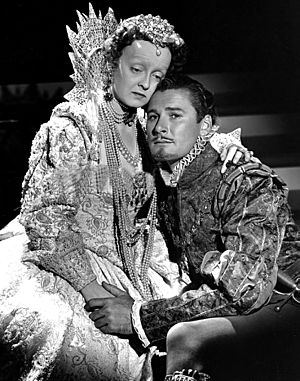
Bette was very emotional while making her next film, Dark Victory (1939). She thought about quitting, but the producer convinced her to use her feelings in her acting. The film was a big hit, and she got another Oscar nomination for it. Bette later said this was her favorite performance. Dark Victory also featured Ronald Reagan and Humphrey Bogart.
She appeared in three other popular films in 1939: The Old Maid, Juarez, and The Private Lives of Elizabeth and Essex. The last one was her first color film. To play the older Queen Elizabeth I of England, Bette shaved her hairline and eyebrows.
By this time, Bette was Warner Bros.' most profitable star. She got the most important female roles. Her image was carefully managed, focusing on her distinctive eyes. All This, and Heaven Too (1940) was her most financially successful film yet.
The Letter (1940) was called "one of the best pictures of the year." During this time, she was in a relationship with her former co-star George Brent. He proposed marriage, but Bette refused. She had met Arthur Farnsworth, an innkeeper from New England. Bette and Farnsworth married in December 1940. This was her second marriage.
In January 1941, Bette became the first female president of the Academy of Motion Picture Arts and Sciences. But she argued with the committee members because of her direct style and new ideas. She resigned and was replaced by the previous president.
Bette starred in three movies in 1941. The first was The Great Lie, where she played a kind character, which was different for her.
William Wyler directed Bette again in The Little Foxes (1941). They disagreed about how to play the character Regina Giddens. Bette wanted to make the role her own, not copy the original stage actress. She received another Oscar nomination for her performance. She never worked with Wyler again after this film.
War Efforts and Personal Life (1942–1944)
Bette Davis was known for her strong and intense acting. She was a perfectionist. She could be tough with studio bosses, directors, and co-stars. She expected everyone to work as hard as she did. Her direct manner, unique way of speaking, and constant cigarette became part of her public image.
After the attack on Pearl Harbor, Bette spent early 1942 selling war bonds. She sold $2 million worth of bonds in two days. She also performed for Black soldiers with a group that included Hattie McDaniel and Lena Horne.
John Garfield suggested opening a club for servicemen in Hollywood. Bette, with help from others, turned an old nightclub into the Hollywood Canteen. It opened on October 3, 1942. Famous Hollywood stars volunteered to entertain soldiers there. Bette made sure important stars were there every night for the soldiers to meet.
She appeared as herself in the film Hollywood Canteen (1944). Bette later said the Hollywood Canteen was one of the few things she was truly proud of. In 1980, she received a high civilian award from the U.S. Department of Defense for her work with the Canteen.
Bette wasn't very interested in the film Now, Voyager (1942) at first. But a producer told her that women needed romantic dramas to escape from real life. It became one of her most famous "women's pictures." In a well-known scene, Paul Henreid lights two cigarettes and gives one to her. Critics praised Bette's performance.
In the early 1940s, some of Bette's film choices were influenced by the war. These included Watch on the Rhine (1943) and Thank Your Lucky Stars (1943). In the latter, she sang a popular song called "They're Either Too Young or Too Old."
Old Acquaintance (1943) brought her back with Miriam Hopkins. The film was about two old friends with tension between them. Bette felt Hopkins tried to outshine her. The director remembered the strong rivalry between the two actresses.
In August 1943, Bette's husband, Arthur Farnsworth, collapsed and died two days later. An investigation found he had a skull fracture from two weeks earlier. Bette said she didn't know how he got the injury. His death was ruled an accident. Bette was very upset and tried to quit her next film, Mr. Skeffington (1944). But Jack Warner convinced her to continue.
Her behavior during filming was unusual. She refused to film some scenes and insisted on rebuilding sets. She made up dialogue, confusing other actors. She also angered the writer by demanding rewrites. Bette later said, "When I was most unhappy, I lashed out rather than whined." Some critics felt her performance was overdone.
Career Challenges (1945–1949)
In 1945, Bette married artist William Grant Sherry, her third husband. She was drawn to him because he claimed he had never heard of her. That same year, Bette turned down the main role in Mildred Pierce (1945), which Joan Crawford took and won an Oscar for. Instead, Bette made The Corn Is Green (1945).
In The Corn Is Green, Bette played Miss Moffat, a teacher who helps a young Welsh miner get an education. Bette insisted on playing the character as an older woman, wearing a gray wig and padding. The film was well-received and made a good profit.
Her next film, A Stolen Life (1946), was the only film Bette made with her own production company. Bette played twin sisters in the movie. Critics didn't like the film much, but it was one of her biggest box office successes. In 1947, the U.S. Treasury named Bette the highest-paid woman in the country. Her next film, Deception (1946), was the first of her films to lose money.
Possessed (1947) was written for Bette, but she became pregnant and went on maternity leave. Joan Crawford took her place in Possessed and was nominated for an Oscar. In 1947, at 39, Bette gave birth to her daughter, Barbara Davis Sherry (known as B.D.). She later wrote that she thought about ending her career to focus on motherhood. However, as she continued making films, her relationship with B.D. began to get difficult, and her popularity with audiences slowly dropped.
Among the roles Bette was offered after returning to acting was Rose Sayer in The African Queen (1951). When she heard the film would be shot in Africa, Bette refused the part. Katharine Hepburn played the role instead and was nominated for an Oscar.
In 1948, Bette was cast in Winter Meeting. She was excited at first, but then learned Warner had arranged "softer" lighting to hide her age. She was also not confident in her male co-star. She disagreed with script changes made due to censorship. The film failed at the box office.
While making June Bride (1948), Bette argued with co-star Robert Montgomery. She called him "a male Miriam Hopkins... an excellent actor, but addicted to scene-stealing." This was her first comedy in years and got some good reviews, but it wasn't very popular.
Despite her recent films not doing well, in 1949, she signed a new contract with Warner Bros. that paid her $10,285 a week, making her the highest-paid woman in the U.S. However, Jack Warner refused to let her approve scripts and cast her in Beyond the Forest (1949). Bette reportedly hated the script and begged Warner to give the role to someone else, but he refused. After the film was finished, her request to leave her contract was granted.
The reviews for Beyond the Forest were very harsh. One critic called it "an unfortunate finale to her brilliant career." The film included the line "What a dump!", which became famous and was often used by impersonators of Bette Davis.
New Beginnings (1949–1960)
Bette filmed The Story of a Divorce (released as Payment on Demand in 1951). She then played a Broadway star in All About Eve (1950). This role earned her another Oscar nomination and won her the Cannes Film Festival Award for Best Actress. Bette loved the script, calling it the best she had ever read. She quickly joined the cast for filming. During production, she became lifelong friends with co-star Anne Baxter and started a romantic relationship with her leading man, Gary Merrill. The director said Bette was a "director's dream" because she was so prepared.
Critics loved Bette's performance. Many of her lines became famous, especially "Fasten your seat belts, it's going to be a bumpy night." She was nominated for an Oscar again. One critic called her Margo character her "all-time best performance." Bette won awards from the Cannes Film Festival and the New York Film Critics Circle. She also got an award from the San Francisco Film Critics Circle, even though they had named her the "Worst Actress of 1949" for Beyond the Forest.
On July 3, 1950, Bette's divorce from William Sherry was final. On July 28, she married Gary Merrill, her fourth and last husband. Gary adopted B.D., Bette's daughter. In January 1951, Bette and Gary adopted a baby girl named Margot. In 1952, they adopted a baby boy named Michael. The family lived on an estate in Cape Elizabeth, Maine. Bette starred in several movies while living in Maine, including The Virgin Queen (1955), where she played Queen Elizabeth I.
The family traveled to England, where Bette and Gary starred in Another Man's Poison (1951). The film got mixed reviews and didn't do well at the box office. Hollywood writers said Bette's comeback had ended. An Oscar nomination for The Star (1952) didn't stop her decline in popularity.
In 1952, Bette appeared in a Broadway show called Two's Company. She wasn't comfortable doing musicals, as her theater experience was limited. She also became very ill and had surgery on her jaw. Her adopted daughter Margot was diagnosed with severe brain damage and was placed in an institution around age 3. Bette and Gary started arguing often.
Few of Bette's films in the 1950s were successful. Many critics disliked her performances. Her films from this time included Storm Center (1956) and The Catered Affair (1956). As her career went down, her marriage also got worse, and she filed for divorce in 1960. The next year, her mother passed away. During this time, she also started acting on television.
In 1960, Bette, a Democrat, attended the 1960 Democratic National Convention. There, she met future President John F. Kennedy, whom she admired greatly. Outside of acting, Bette was an active member of the Episcopal Church.
Renewed Success (1961–1970)
In 1961, Bette opened in a Broadway play called The Night of the Iguana. She left after four months due to illness. She then joined Glenn Ford and Hope Lange in the film Pocketful of Miracles (1961). The film didn't do well at the box office.
Her last Oscar nomination was for the horror film What Ever Happened to Baby Jane? (1962). This film also starred Joan Crawford. Joan Crawford was interested in the script and thought of Bette for the role of Jane. Bette believed the film could be popular. She made a deal to get 10 percent of the film's worldwide profits, plus her salary. The film became a huge success.
Bette and Joan Crawford played two aging sisters who were former actresses. The director said that Bette and Joan truly disliked each other. But they behaved perfectly because they knew how important the film was for their careers.
After filming, their public comments against each other turned into a lifelong feud. When Bette was nominated for an Oscar, Joan Crawford offered to accept the award for other nominees if they won. When Anne Bancroft won, Crawford accepted the award for her. Despite their dislike, both Bette and Joan spoke highly of each other's acting talent. Their feud was later made into a TV series called Feud in 2017.
Bette also received her only BAFTA nomination for this role. Her daughter Barbara (credited as B.D. Merrill) had a small part in the film. When they visited the Cannes Film Festival to promote it, Barbara met Jeremy Hyman. She married him at 16, with Bette's permission.

In October 1962, it was announced that Bette would be a special guest star on the TV series Perry Mason. She was a fan of the show. Her episode, "The Case of Constant Doyle", aired in January 1963.
In 1962, Bette also appeared in an episode of the TV Western The Virginian.
In September 1962, Bette placed a funny advertisement in a magazine. It said: "Mother of three – 10, 11, & 15 – divorcee. American. Thirty years experience as an actress in Motion Pictures. Mobile still, and more affable than rumor would have it. Wants steady employment in Hollywood. (Has had Broadway.)" Bette said it was a joke, and her career continued to be successful for several years.
Dead Ringer (1964) was a crime drama where she played twin sisters. Where Love Has Gone (1964) was a romantic drama. Bette played the mother of Susan Hayward, but filming was difficult due to arguments between the two actresses.
Hush...Hush, Sweet Charlotte (1964) was the next film by the director of What Ever Happened to Baby Jane?. He planned to reunite Bette and Joan Crawford, but Joan left the film due to illness. Olivia de Havilland replaced her. The film was a big success and brought new attention to its veteran cast.
The next year, Bette was cast in a TV comedy show, but the pilot episode was not picked up. By the end of the 1960s, Bette had appeared in some British films that were not well-received, and her career slowed down again.
Later Career and Awards (1971–1983)
In the early 1970s, Bette was invited to a stage show in New York City called Great Ladies of the American Cinema. She talked about her career and answered questions from the audience. She was well-received and later toured Australia and the United Kingdom with a similar show.
In 1972, Bette played lead roles in two TV films meant to be pilots for new series, Madame Sin and The Judge and Jake Wyler. But neither network decided to make a series.
She appeared in a stage musical, Miss Moffat, based on her film The Corn Is Green. But after bad reviews, she left the show due to a back injury, and it closed.
She played supporting roles in a few films, including Burnt Offerings (1976). She had disagreements with the stars of these films, feeling they didn't show her enough respect.
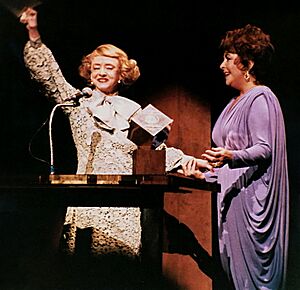
In 1977, Bette became the first woman to receive the American Film Institute's Lifetime Achievement Award. The televised event included comments from her colleagues. After this, she was in demand again and had many offers. She accepted roles in the TV miniseries The Dark Secret of Harvest Home (1978) and the film Death on the Nile (1978), an Agatha Christie mystery.
Most of her later work was for television. She won an Emmy Award for Strangers: The Story of a Mother and Daughter (1979). She was also nominated for her performances in White Mama (1980) and Little Gloria... Happy at Last (1982). She also had supporting roles in Disney films like Return from Witch Mountain (1978).
Bette's name became known to a younger audience when Kim Carnes's song "Bette Davis Eyes" became a worldwide hit in 1981. Bette's grandson was impressed. Bette saw it as a compliment and thanked Carnes and the songwriters.
She continued acting for television, appearing in Family Reunion (1981) with her grandson, A Piano for Mrs. Cimino (1982), and Right of Way (1983) with James Stewart. In 1983, she received the Women in Film Crystal Award.
Final Years and Legacy (1983–1989)
Bette's career had ups and downs. Despite long periods of illness, she kept acting until shortly before her death from breast cancer in 1989. She admitted that her success often came at the cost of her personal relationships. She was married four times. She raised her children mostly as a single parent.
In 1983, after filming a TV pilot, Bette was diagnosed with breast cancer and had surgery. Two weeks later, she had four strokes. These caused paralysis on the left side of her face and arm, and made her speech slurred. She went through a long period of physical therapy and slowly recovered some movement. Even late in life, Bette smoked a lot.
During this time, her relationship with her daughter B.D. Hyman got worse. B.D. published a book called My Mother's Keeper. In it, she wrote about a difficult mother-daughter relationship and described Bette's controlling behavior.
Some of Bette's friends said B.D.'s book was not accurate. Her ex-husband, Gary Merrill, also defended Bette, saying B.D. was motivated by "cruelty and greed." Bette's adopted son, Michael Merrill, stopped talking to B.D. Bette also cut ties with her daughter and removed her from her will.
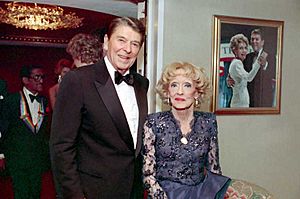
In her second memoir, This 'n That (1987), Bette wrote that she was still recovering from her daughter's book. She said it was as shattering as her stroke. Her memoir ended with a letter to her daughter, saying she had been her "keeper" for many years.
Bette appeared in the TV film As Summers Die (1986) and in the film The Whales of August (1987). In this film, she played the blind sister of Lillian Gish. Even though she was in poor health, Bette memorized all her lines, as she always did. The film received good reviews. In 1987, Bette was honored at the Kennedy Center Honors for her contributions to film.
Her last performance was in the film Wicked Stepmother (1989). By this time, her health was failing, and she left the set after disagreements. The script was changed, and the film was released after Bette's death.
After leaving Wicked Stepmother, Bette appeared on several talk shows. She discussed her career but refused to talk about her daughter. Her appearances were popular.
In 1988 and 1989, Bette was honored for her career achievements. She received awards from France, Italy, and the Film Society of Lincoln Center. She also appeared on British television to discuss her career.
Death
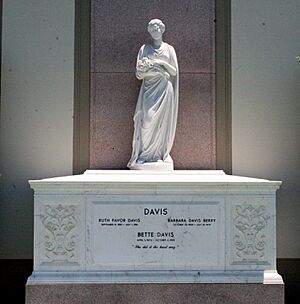
Bette collapsed during an awards ceremony in 1989. She found out her cancer had returned. She recovered enough to travel to Spain for an award, but her health quickly got worse. She was too weak to travel back to the U.S. and died in France on October 6, 1989, at the age of 81.
She was buried in Forest Lawn-Hollywood Hills Cemetery in Los Angeles. Her tombstone reads: "She did it the hard way." This was an epitaph she mentioned in her memoir, suggested by director Joseph L. Mankiewicz after they filmed All About Eve.
Academy Awards
Bette Davis set several Oscar records. She was the first person to get five Oscar nominations in a row for Best Actress (1938–1942). Only one other actress, Greer Garson, has matched this record.
In 1962, Bette Davis became the first person to get 10 Oscar nominations for acting. Since then, only three other actors have received more nominations: Meryl Streep, Katharine Hepburn, and Jack Nicholson. Laurence Olivier also matched her record of 10 nominations.
Steven Spielberg bought Bette Davis's Oscars for Dangerous (1935) and Jezebel (1938) when they were sold at auction. He returned them to the Academy of Motion Picture Arts and Sciences.
Bette's performance in Of Human Bondage (1934) was highly praised. When she wasn't nominated for an Oscar, many important people campaigned for her. The Academy changed its rules for that year to allow write-in votes. Bette actually placed third in the voting for Best Actress that year.
| Year | Category | Film | Result |
|---|---|---|---|
| 1934 | Best Actress | Of Human Bondage | Nominated (Write-in) |
| 1935 | Dangerous | Won | |
| 1938 | Jezebel | ||
| 1939 | Dark Victory | Nominated | |
| 1940 | The Letter | ||
| 1941 | The Little Foxes | ||
| 1942 | Now, Voyager | ||
| 1944 | Mr. Skeffington | ||
| 1950 | All About Eve | ||
| 1952 | The Star | ||
| 1962 | What Ever Happened to Baby Jane? |
Selected Filmography
- Bad Sister (1931)
- 20,000 Years in Sing Sing (1932)
- The Cabin in the Cotton (1932)
- The Working Man (1933)
- Parachute Jumper (1933)
- Of Human Bondage (1934)
- Dangerous (1935)
- The Petrified Forest (1936)
- Marked Woman (1937)
- Jezebel (1938)
- Dark Victory (1939)
- The Old Maid (1939)
- The Private Lives of Elizabeth and Essex (1939)
- Juarez (1939)
- All This, and Heaven Too (1940)
- The Letter (1940)
- The Bride Came C.O.D. (1941)
- The Little Foxes (1941)
- The Great Lie (1941)
- The Man Who Came to Dinner (1942)
- In This Our Life (1942)
- Now, Voyager (1942)
- Watch on the Rhine (1943)
- Old Acquaintance (1943)
- Mr. Skeffington (1944)
- The Corn Is Green (1945)
- A Stolen Life (1946)
- Deception (1946)
- Winter Meeting (1948)
- Beyond the Forest (1949)
- All About Eve (1950)
- Payment on Demand (1951)
- Another Man's Poison (1951)
- Phone Call from a Stranger (1952)
- The Star (1952)
- The Virgin Queen (1955)
- The Catered Affair (1956)
- Pocketful of Miracles (1961)
- What Ever Happened to Baby Jane? (1962)
- Hush...Hush, Sweet Charlotte (1964)
- Dead Ringer (1964)
- The Nanny (1965)
- The Anniversary (1968)
- Connecting Rooms (1970)
- Burnt Offerings (1976)
- Return from Witch Mountain (1978)
- Death on the Nile (1978)
- Strangers: The Story of a Mother and Daughter (1979)
- The Watcher in the Woods (1980)
- Right of Way (1983)
- As Summers Die (1986)
- The Whales of August (1987)
- Wicked Stepmother (1989)
Images for kids
-
Davis with Errol Flynn in The Private Lives of Elizabeth and Essex (1939).
-
Davis with Spencer Tracy at the 1939 Academy Awards.
-
Davis with Paul Henreid in Now, Voyager (1942), one of her most iconic roles.
-
Davis posing as Margo Channing in a promotional image for All About Eve (1950): She is pictured with Gary Merrill, to whom she was married from 1950 to 1960 (her fourth, and final, husband).
-
Davis and William Hopper in the Perry Mason episode "The Case of Constant Doyle" (1963).
-
Davis (left) and Elizabeth Taylor in late 1981 during a show celebrating Taylor's life.
-
Davis with President Ronald Reagan (her co-star in 1939's Dark Victory) in 1987, two years before her death.
-
Davis's crypt at Forest Lawn Memorial Park in Los Angeles.
See also
 In Spanish: Bette Davis para niños
In Spanish: Bette Davis para niños



